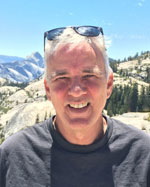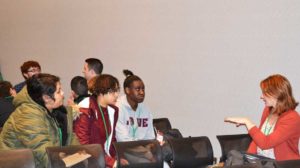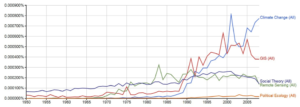The Creation of Transformative Geographies
 We all like to think of ourselves as being transformative in one way or the other. Indeed, we all are. In our personal interactions and the examples we set, we can transform the lives of those around us. Gifted teachers and graduate advisors play a critical role in transforming the lives of their students, and it is from such teachers that our discipline attracts new adherents and grows. The importance and power of the transformative process of education, student by student, classroom by classroom, department by department, cannot be overvalued. Because of its innately transformative role, teaching should always be highly regarded by our Association and by each and every one of us.
We all like to think of ourselves as being transformative in one way or the other. Indeed, we all are. In our personal interactions and the examples we set, we can transform the lives of those around us. Gifted teachers and graduate advisors play a critical role in transforming the lives of their students, and it is from such teachers that our discipline attracts new adherents and grows. The importance and power of the transformative process of education, student by student, classroom by classroom, department by department, cannot be overvalued. Because of its innately transformative role, teaching should always be highly regarded by our Association and by each and every one of us.
Those of us who are researchers would like to also think that our particular areas of investigation and our own scholarship are transformative. I was once told of a geographical journal editor who remarked that everything published in the journal was transformative. Sadly, publishing a peer-reviewed article provides no guarantee of transforming the scholarship of others. A few years back The Chronicle of Higher Education reported that 55 to 60 percent of all articles published in natural sciences and social sciences journals were not cited by other researchers. I suppose though, that even if a piece of published research is never read or cited, the conducting of the research and its distillation into an article is at least transformative for the authors.
 Now, I would expect that most geographers do indeed see much of their published work cited by others. Interestingly, a study published online by the London School of Economics and Public Policy showed that geographers had higher citation h-Index values than economists, political scientists, sociologists and law faculty. Perhaps we may take some comfort that our publications are cited and judge our work to be transformational. I suppose in a way it is, in so far as our techniques, results and interpretation will help guide the work of other scholars. However, how often do we pause to consider what is meant by the term transformative research at the broadest and most influential scale? Are we endeavoring to educate our students as to the meaning and formulation of truly transformational research? How can we, our Association and the discipline in general work to create truly transformational geographers and geographies?
Now, I would expect that most geographers do indeed see much of their published work cited by others. Interestingly, a study published online by the London School of Economics and Public Policy showed that geographers had higher citation h-Index values than economists, political scientists, sociologists and law faculty. Perhaps we may take some comfort that our publications are cited and judge our work to be transformational. I suppose in a way it is, in so far as our techniques, results and interpretation will help guide the work of other scholars. However, how often do we pause to consider what is meant by the term transformative research at the broadest and most influential scale? Are we endeavoring to educate our students as to the meaning and formulation of truly transformational research? How can we, our Association and the discipline in general work to create truly transformational geographers and geographies?
What is Transformative Research?
Several years ago, Mike Goodchild, Amy Glasmeier and I were asked by the National Research Council to convene a workshop of eminent geographers to examine the history of recent transformative research events in geography and see what lessons might be drawn to promote future transformative research. A prepublication copy of the report Fostering Transformative Research in the Geographical Sciences is available online from the National Academies Press. The first thing we had to grapple with is the definition of what is truly transformative research. There are a number of such definitions out there – often provided by national research councils and funding agencies. The National Science Foundation provides a succinct definition “Transformative research involves ideas, discoveries, or tools that radically change our understanding of an important existing scientific or engineering concept or educational practice or leads to the creation of a new paradigm or field of science, engineering, or education.” So, truly transformative research does not simply add new methods, results, and interpretations, but radically changes or creates the paradigms by which disciplines operate.
In considering transformative research in the context of the recent history of geography I sometimes think about it this way. What are some of the important and pervasive areas of geographical research today that did not exist or were of incipient and minor importance a generation of two ago? During our workshop several of these areas bubbled up. These included Political Ecology, Spatial Social Theory, Remote Sensing of the Environment, Geographic Information Sciences (GIS), and Global Climate Change. The list above is clearly not exhaustive, but you get the idea. Although the antecedents and underpinnings of these research areas would have been detectable in the geography of the 1940s, no prewar geographer was likely to identify herself as a being a political ecologist or GIS specialist.
Another hallmark of transformational research in the context of geography is that there is a great fluidity of ideas between our discipline and other disciplines. What has been transformative within geography has not necessarily been conceived and developed strictly within our discipline. Geographers have made important contributions to the development of political ecology and spatial social theory, but geographers have also been influenced by the work of others such as anthropologists and sociologists. We may wish to claim GIS as our own, and indeed the Anglo-Canadian geographer Roger Tomlinson played a seminal role, but it should be remembered that Howard Fisher, an architect and founder of the Laboratory for Computer at Harvard and landscape architect, Jack Dangermond, also played critical roles in the inception of GIS. However, it is also clear that the work of geographers in transformational research areas often informs and transforms other disciplines. Consider the impact that the work on spatial social theory by David Harvey has had across a range of social sciences. I believe that the rise of Geo Humanities represents a wave of transformational research that is developing and influencing scholarship within geography and beyond.

How Can Transformational Geographers Be Created?
How, at an early stage, might we identify those scholars who will be truly transformational? In our analysis of the workshop and examples we gleaned we were not able to able to delineate any predictive individual profile or unique hallmarks of the truly transformational scholars. Who they were, where they worked and how they worked ran a gamut. In reflecting on this it seems to me that there were two variables we might influence to help create transformational geographers and geographers. The first is imparting to our students a sense of what truly transformational scholarship is and instilling the vision that one can set a goal of being transformational. The second is providing the matrix of opportunities and mechanisms that allow transformational research to develop and flourish.
I had a wonderful undergraduate and graduate educational experience. My teachers and advisors imparted many valuable lessons on how to conduct research and perform as a scholar. However, never once was I exposed to the idea of striving to truly transform my own discipline. I was exposed to Thomas Kuhn’s book The Structure of Scientific Revolutions and the idea of paradigm shifts in science. However, this seemed highly philosophical and remote – not something that I or any other graduate student might strive for. Perhaps I, as many others, was more comfortable in the confines of Karl Popper’s idealized narrower approach of hypothesis generation and refutation.
I suggest that in training graduate students we consider how we can inspire students to at least consider the goal of being paradigm creators and true transformers of the discipline of geography. Narratives have great power to teach and inspire. Let’s tell aspiring scholars the stories of transformation and the stories of those who have affected it. Analyze in class the recent history of the discipline and current directions with a focus firmly on the questions of the transformative paradigms and personages, and how they were able to shape the discipline. Let’s set a goal of training students not just to be stellar scholars, but transformative ones. Certainly not everyone will join the pantheon of those who have truly transformed geography, but at least students will have such goals on their radar. In addition, as I will argue below, the creation of true transformative research is a team effort and the more scholars who are knowingly engaged the more likely we are to create transformational geographies.
How Can We Foster Transformational Geographies?
If we cannot at an early stage identify transformative geographers, perhaps we can provide for them the matrix of opportunities and mechanisms that allow transformational research to develop and flourish. One way to look at the development and spread of transformational research innovations and associated new paradigms is through the lens of diffusion of innovation models. The classic model was developed by Everett Rogers in the 1960s. He posited that the spread of innovation took the form of a logistic curve. A very small number of innovators create an initial idea, it this then taken up by a small, but growing group of early adopters and then rapidly adopted by the majority of users. Eventually the market for the innovation is saturated and the rate of adoption stabilizes. If we look at the use of terms such as Political Ecology, Social Theory, Remote Sensing of the Environment, Geographic Information Sciences (GIS), and Global Climate Change in books one can see a similar logistic pattern of the growth in use over time.

Now, although our study of past transformative research in the geographical sciences did not provide any magic metrics to identify who individual transformative scholars might be, we did identify important aspects of the environments and processes by which their innovative ideas were developed, communicated and eventually transformed disciplines. Here are some. First of all, there is typically much two-way exchange of information between initial innovators and early adopters. A brilliant individual may have an idea, but it takes a team to really develop and diffuse it fully. This team approach of two-way communication allows for more effective refinements and expansions of initial ideas. This not only improves innovations, but increased rates of further adoption. Second, mechanisms for rapid communication and networking between innovators, early adopters and later adopters are important for allowing innovations to develop and spread rapidly. Third, diversity of perspectives by innovators and adopters is important for both innovation refinement and expanding applications. Fourth, a process of “open source” information exchange between innovators and adopters is more efficient than small and secretive groups keeping closely held information in the pursuit of competitive advantage. Finally, based upon the importance of the early interface stage where innovators and early adopters are working to refine and spread new innovations, we felt that this was a critical time for the allocation of support such as targeted research funding for transformative research.
As individuals and an association there are, I believe, some important lessons we might take from this all as we strive to develop the transformative geographies of the future. We should be supportive of new methods, ideas and paradigms. We should encourage diversity of participants and perspectives in research. We should embrace an open-source model of scholarship which values free exchange of ideas within geography and between geographers and other disciplines. The AAG must strive to be a nexus in that open-source endeavor. Through provision of networking opportunities such as the annual meeting and the communication mechanisms provided by our meetings and journals the Association has a critical role to play here. Most importantly though, we as individual educators and as an association must teach our students not just to be competent scholars, but explicitly inspire them with examples of transformative research and transformative researchers to reach for such heights themselves. The creators of the transformative geographies of the future are in our classrooms and meeting sessions right now. Let’s do our best to help them recognize their own transformative potential.
Join the conversation on Twitter #PresidentAAG
—Glen M. MacDonald
DOI: 10.14433/2017.0006

